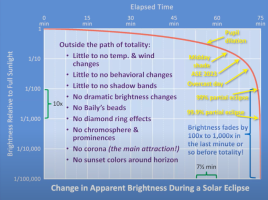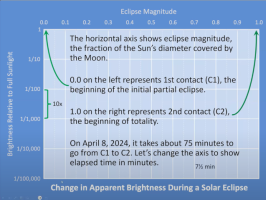Dr.Peterson
Elite Member
- Joined
- Nov 12, 2017
- Messages
- 16,619
Because the center line of the total eclipse Monday will be one town over from mine (3 min 42 sec of totality), I was looking into how dark I can expect the sky to be. I found this article, which contained this video, which I found interesting mathematically:
Two things seem wrong to me, despite its good credentials. First, the horizontal scale is initially presented as the percent of the sun covered, and then changed to time from the start of a partial eclipse to the start of totality:
I'm sure it isn't really linear; I haven't yet worked out the actual function, to see how far off it actually is.
Second, this is only about the amount of light we get from the sun (on a logarithmic scale), and not about the actual illumination we see. It won't necessarily get pitch-black, and certainly not as soon as totality begins, since at that point half of the sky we see is still in the light. The article says that because the zone of totality is wider this time than in 2017, it will get darker, as more of the sky we see will be within the shadow (at least where I am) -- but not totally.
But the qualitative points made are valid in spite of my quibbles. Even if it turns out to be cloudy, it will be impressive.
I'm looking forward to seeing how much will surprise me; I know it will be totally different from the partial eclipse I saw in 2017, and even the perfect annular eclipse I saw from home in 1994.
Two things seem wrong to me, despite its good credentials. First, the horizontal scale is initially presented as the percent of the sun covered, and then changed to time from the start of a partial eclipse to the start of totality:
I'm sure it isn't really linear; I haven't yet worked out the actual function, to see how far off it actually is.
Second, this is only about the amount of light we get from the sun (on a logarithmic scale), and not about the actual illumination we see. It won't necessarily get pitch-black, and certainly not as soon as totality begins, since at that point half of the sky we see is still in the light. The article says that because the zone of totality is wider this time than in 2017, it will get darker, as more of the sky we see will be within the shadow (at least where I am) -- but not totally.
But the qualitative points made are valid in spite of my quibbles. Even if it turns out to be cloudy, it will be impressive.
I'm looking forward to seeing how much will surprise me; I know it will be totally different from the partial eclipse I saw in 2017, and even the perfect annular eclipse I saw from home in 1994.


